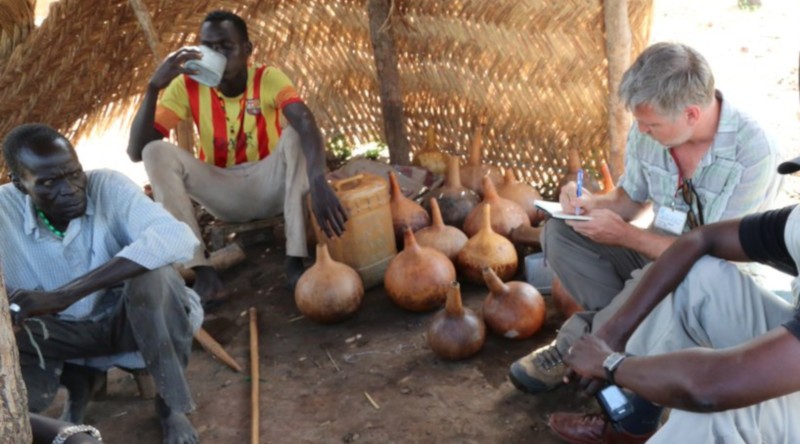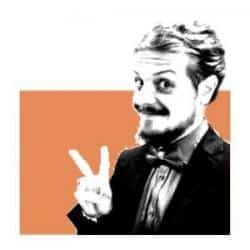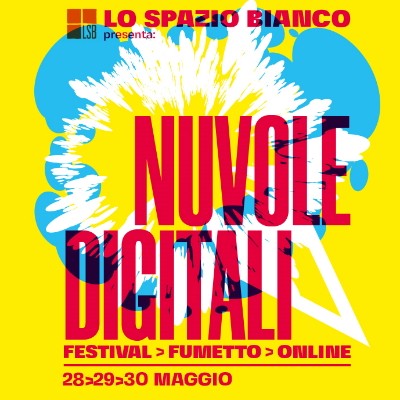Being active in the professional world of US comics since more than 20 years, Joshua Dysart stands out among US mainstream comic books authors: since his debut he has focused his storytelling on real-world stories, especially those coming from places affected by poverty and war, places of which very few people speak with knowledge. Unknown Soldier, Harbinger, Imperium, The Life and Death of Toyo Harada, until Living Level 3: a red thread binds all these stories, a thread that passes through some of the poorest countries of our world, from Iraq to Uganda, from Somalia to Sud Sudan. On the occasion of the release of the Italian edition of Living Level 3 we interviewed Joshua Dysart, talking with him about his influences, his career and what pushes him to write stories.
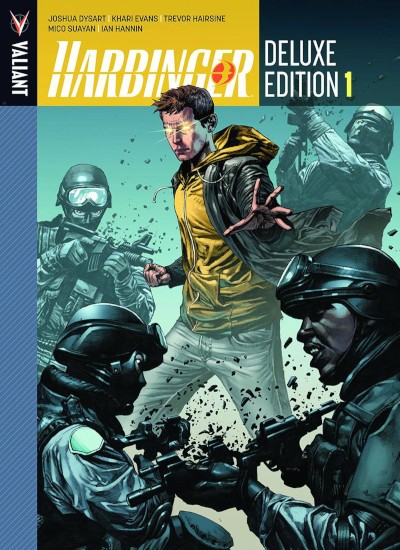 Hi Joshua and thanks for your time. I would like to start this interview talking about the beginning of your career: which were the first steps that lead you to write comics?
Hi Joshua and thanks for your time. I would like to start this interview talking about the beginning of your career: which were the first steps that lead you to write comics?
I’ve always loved comics, but my real career started when a friend of mine, Jan Utstein, whom I had done some script supervising work for fell in love with a comic book artist, Bill O’Neill. Knowing I loved comic books, she contacted me and asked me if I wanted to write something for her boy to draw. Something we could all publish and own together. Up to that point Jan had been a film producer and production designer. Now she’s an accountant on the Marvel films. Bill’s pitch to me was, “Batman meets Silence of the Lambs.” I didn’t love that idea and I resisted writing it for a while. This was 1994, I think. At the end of ’94, and into ’95 I went traveling around Mexico. I landed in country a few months after the PRI presidential candidate Luis Donaldo Colosio Murrieta was assassinated. It was an astonishing political time for the country. It was the Chiapas conflict that really awakened the political activist in me. Anyway, I came back to the States sometime late in 1995, and I was flat broke from my trip. So I called up Jan and Bill and, lo-and-behold, they had waited for me. So I took the concept and began to rework it as something that interested me. That became Violent Messiahs. We published it first in black and white in 1996, with Bill drawing, but only released one issue. The market really bottomed out on us. Later Tone Rodriguez came on as the artist and we put out the 2000 Image version which really kick started my career. There was still a lot of struggle. I’ve been very, very broke most of my life, but that was the starting gun.
Which were the greatest influences during your artistic development?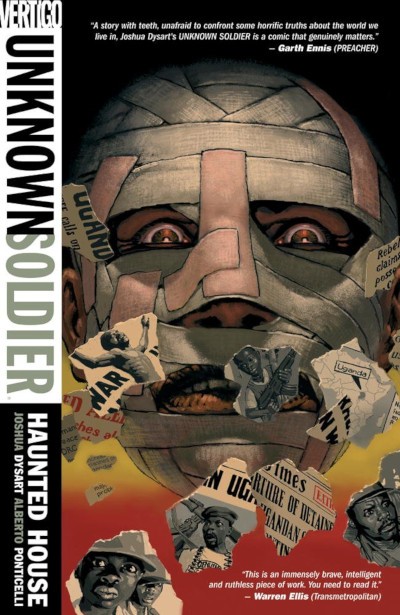
That’s obviously a huge conversation. So many things influenced and continue to influence me. My introductory comic book was a reprint of Robert Crumb’s Zapped that I found in the stack of Playboys my father left in the house after my parent’s got divorced. And so Crumb became the first artist whose style I recognized because my mother also had stacks of records in the living room and Crumb had done the cover for a Big Brother and the Holding Company album, featuring Janis Joplin. I loved when my mom would put that record on. By the time I’d found Zapped buried in that pile of confusing female nudity I’d already read and reread the Big Brother album cover many times. Trying to discern a story from its “panels”, building up a tolerance for the absurd, the disconnected, and the visually illustrated. So it went that the dawning of the very idea of a comic book to me was smeared with the contagion of sex and Rock ‘n’ Roll, even before the power of either of those things held sway over my spirit and body. Comics never represented innocence or escapism to me. They represented dissonance and confrontation. After discovering my first comic book I started shopping the spinner racks at the local corner store. Then my first local comic book store opened during the initial direct market wave of retailers and I found a real community there. A week didn’t go by that my mom didn’t have to take me. That was the first place I ever laid my thirsty eyes on role-playing games as well, which were a profound part of me becoming creatively empowered.
Beyond that I read almost exclusively science fiction and horror as a kid. A fuckton of it. And it’s through science fiction writers, like Le Guin, Herbert, Clarke, Bradbury, Heinlein, Dick, Butler, Banks, etc., that I came to be introduced to the central tenants and philosophies of humanism. I also took huge inspiration from films, I had a cousin who was the closest thing to a father I’ve ever had, and he exposed me to a lot of foreign film and “high-art” cinema from a young age. Even from before I could read subtitles I was mesmerized by the images. But I was also a kid, so I loved grimy pulp stuff too. John Carpenter is probably one of the biggest influences on me in that regard, but I was also a huge Mad Max fan. I loved that way more than Star Wars (which I did love).
And music played a role in my creative development, as well. There was a lot of classic rock and roll and soul music in my house growing up, and also Texas rebel country music, since my uncle who lived with us was a professional honky tonk musician. Later this love of music turned into an obsession with metal and punk, and then ultimately with pretty much all music. Music is the voice of God. The devil has no music.
As far as comics go, I’m really a child of the 80’s. Mostly the black and white boom (Love and Rockets, Cerebus, etc.), but also, of course, I was buying Watchman and Dark Knight as they were coming out, and reading the first American editions of Akira. I loved Nexus and Badger and Ronin (Ronin was huge for me). I loved 2000 AD, and even ran an epic Judge Dredd role playing game for a while. It was a great time for comics.
Lastly, life, people, the construct that is humanity and how it interfaces with the universe around it, these are my greatest influences. I’m fascinated by our coping mechanisms, personality flaws, sense of wonder, our faith constructs, our ambitions, our failures, and the institutions we erect to support, express, and often suppress, it all. If my work feels a little off from other work in the field it might be because of my relentless searching for inspiration from the real world and not from other artists so much anymore.
It’s hard to talk about influences, because they’re always evolving. I’m inspired every day by something.
One of your biggest hits is Unknown Soldier, which you realized together with Alberto Ponticelli e Pat Masioni. It was an Eisner-nominee series and received praises from both fans and critics. A story that, even reading it today, feels dramatically current and very innovative in the context of US comics production. What do you remember about that experience and what did it mean for you?
I mean, that book is huge in my career and in my life. The experiences I had researching it are absolutely definitive. Going to an East African conflict zone. Traveling with Acholi child combatants. It’s the most significant thing I’ve ever done. In many ways the journey I took for the research on that book, and the way that it shaped me, is so much more important than the comic book we managed to hammer out of it. It’s very hard to talk superficially about it. I don’t really have words for it. But that trip recoded me.
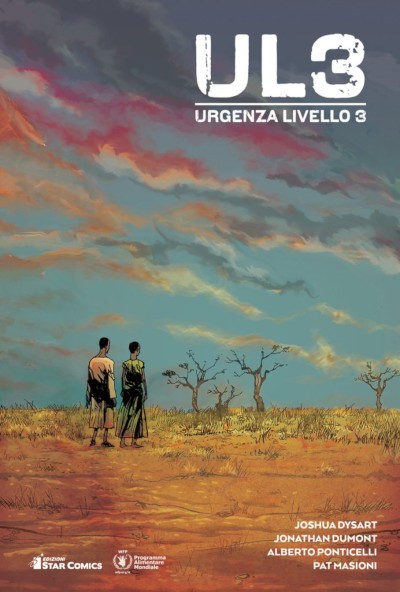 Talking about Unknown Soldier gives us the opportunity to introduce another comic that you did again together with Ponticelli and Masioni, namely Living Level 3. The story talks about the work of the World Food Program (WFP) and it allowed you to write once again about countries devastated by war and violence. How did this comic come to life and which kind of experience has been working outside the production logic of comic books industry?
Talking about Unknown Soldier gives us the opportunity to introduce another comic that you did again together with Ponticelli and Masioni, namely Living Level 3. The story talks about the work of the World Food Program (WFP) and it allowed you to write once again about countries devastated by war and violence. How did this comic come to life and which kind of experience has been working outside the production logic of comic books industry?
I had heard from a friend that the WFP was looking for a comic book writer to take with them into destabilized areas so that they could use the medium to illuminate what the WFP does and the populations they serve. I wanted that job very, very badly. It had been six or seven years since my time in Acholiland, Uganda, and I had been doing mostly “superhero” comics for Valiant in that time. I was hungry to observe and then recount something meaningful and essentially human. To place someone other than myself at the center of my consciousness. I was tired of fiction. So I lobbied for the gig and I got it.
To be honest, it turned out to be rather frustrating working outside of a comic book publisher. On the one hand, the material was of no interest to American publishers, and really, still isn’t. I’m trying to find an American publisher to put it out in physical media and no one seems interested. On the other hand, dealing with the internal politics of the WFP, while necessary to uphold their radical neutrality position, was a huge pain in the ass. Kind of a nightmare actually. At one point we were arguing over whether I could mention that Da’esh was the perpetrator of the violence in Northern, Iraq (I won that one). Another time I was told I couldn’t use the terms “President” and “Vice President” in a story explaining the troubles in South Sudan, precisely because a conflict between the President and Vice President were the actual source of many of those troubles (I didn’t win that one). I was always receiving last minute changes, sometimes even after the art was done, and I would have to contort the scripts so that they both fulfilled the mission of education, but didn’t politically offend people that, to be honest, were pretty offensive themselves. All of this I do understand. This is a political organization with people on the ground in some of the most difficult environments in the world. Their safety and the mission is so much more important than a silly comic book about the mission, but it was tough.
But really, most of the frustration has come from the WFP not having any of the distribution connections of a large publishing house. Mostly that work has sunk into obscurity here in the States because they chose temporary platforms for distribution, like Huffington Post and Mashable, hack sites that have high hits, but aren’t actually taken very seriously. To be fair, we tried to interest the New York Times, the New Yorker, and other less compromised platforms, but they didn’t seem very interested, perhaps because the work walks and talks like fiction, which was part of us trying to make it accessible. There was already plenty of non-fiction about these events out there. (Actually the South Sudan famine was woefully underreported at the time we published LL-3: South Sudan.)
Was it your idea to involve Ponticelli and Masioni? What’s the relationship that bonds you to them and why are they the most suited to tell this kind of stories, in your opinion?
Yes, I got Ponticelli and Masioni involved. We all met doing Unknown Soldier and I just think that because Alberto and Pat both have their own unique global perspective on sequential art storytelling (Alberto being Italian and Pat being Congolese living in Paris) that it makes the work feel more universal and layered. I have to be a global citizen as well when I work with them. It helps me be more honest about the scope of humanity, which is the core of work like this. We could use a woman on the team, which we later got in the amazing colorist Giulia Brusco, for Goodnight Paradise.
But also, I have kind of stolen Alberto away from his own voice in many ways. If not for me I don’t think he would be working on social realism comics, so I’m very, very grateful for being my collaborator for more than a decade now. The next time Alberto and I work together, and we’re cooking that up, so look for it, it will be something else entirely. Just as full of humanism and depth, but completely divorced from social realism. I want to help Alberto express his voice like he has helped me express my own. What you have to understand is that Alberto is family. My brother from another mother. I will give to him whatever he needs to feel the most sustained and complete person he can be. Without even trying to, he has done that for me many, many times.
 During the last eight years you have been writing mainly for Valiant Entertainment: in 2012 you have been one of the main authors involved in the relaunch of the publisher, writing Harbinger first and then contribuiting to the development of Toyo Harada, both in Imperium and Life and Death of Toyo Harada. How has been your working experience with this publisher so far?
During the last eight years you have been writing mainly for Valiant Entertainment: in 2012 you have been one of the main authors involved in the relaunch of the publisher, writing Harbinger first and then contribuiting to the development of Toyo Harada, both in Imperium and Life and Death of Toyo Harada. How has been your working experience with this publisher so far?
It was a magical thing to start fresh with a brand new publisher and be a part of the guiding force behind those stories. I really cherish all of those people, from marketing to editorial to management to creative. It marked the 2010’s for me. But now it also feels very good to be starting new things, to move in new directions. So I don’t think I’ll be doing much more work for Valiant anytime soon. It feels a little too much like going backwards to work for them again. But yeah, I was really fortunate to be a part of that. And the Psiot Cycle (Harbinger, Harbinger Omegas, Imperium, and Life and Death of Toyo Harada) is probably the longest form work I’ll ever get to do in this medium. I owe a huge debt to Dinesh and Warren for believing in me and letting me get that story told.
Toyo Harada is, in my opinion, one of the most fascinating and multifaceted characters of the entire US-comics landscape of the last years: he is controversial, radical, he attracts and repels the reader at the same time. You cannot decide if you want to see him triumphant or defeated. Who is Toyo Harada for you, what does he represent and how did you decide to develop him in this direction?
Wow, that’s awesome. Thank you. Harada is a personification of my own personal rage at the fact that we allow people to suffer. Our “isms”, our systems, our apathy, and our ambitions make the world less tenable. It seems impossible to have progress without creating suffering. Humanity is one conflicted Gordian Knot of quarrel and suffering and selfishness. We are pulled between a new emerging concept of the moral consciousness and our own sordid animal instincts. Imposed scarcity, war for profit, purposeful lying, it’s all in service to human greed. I wanted to scream about that in story form, in character form. At the same time, I knew it would take tremendous power to change the course of humanity. And power is not something to be trusted. Power is frightening. Harada fights for complete equality of all man, yet he himself has power and privilege beyond all human reason. This is where all the contradictive energy in the character comes from. He is the answer and he is the problem at the same time. It that feels like the internal human conflict to me.
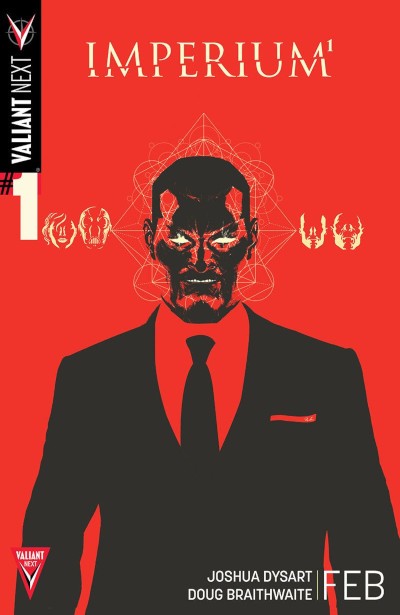 There is a red thread that connects all your works, that is political and social commitment, especially aimed at showing the condition of the most critical areas of the world. Do you think that comics and art in general have a duty to talk about these topics and bring the world’s problems to people’s attention? What could be the contribution of comics to this and what should be implemented more?
There is a red thread that connects all your works, that is political and social commitment, especially aimed at showing the condition of the most critical areas of the world. Do you think that comics and art in general have a duty to talk about these topics and bring the world’s problems to people’s attention? What could be the contribution of comics to this and what should be implemented more?
No, it’s not a duty. There should be room for all kinds of art and storytelling, from the most escapist (there’s no such thing actually, there is no escape, but people can try), to the most nihilist, to the most concerned and humanist. But it does feel like my own personal duty. And this goes back to when you asked about my influences and I said my biggest influence is humanity. I can’t say why. Maybe it’s because of the things I’ve seen traveling in four low-impact guerrilla war zones, two mega-slums, and one famine area. Or maybe I went to those places becaue I was driven by a need to see and understand. All I know is that I feel most comfortanle telling stories about people who have very little percieved power in this world, and then helping the reader find those character’s place in that reader’s heart. Because I want my work to be an empathy engine. I want to leave the world a better place – even in the smallest, most minute of ways – than how I came into it.
The problem is the audience, most especially here in the States, but it’s true globally as well. There is very little appetite for stories about the global human condition. Either because it makes the audience feel powerless, or beacuase of apathy, or because it challenges their wealth fantasies. I don’t really know why. But other than personal reward, I very often feel like I’ve wasted my life telling these kind of stories. Unknown Soldier is virtually out of print. Living Level-3 has trouble finding publishers. Goodnight Paradise is only a year old and already feels so obscure to most readers. I can’t change who I am, or what inspires me to tell stories, but lately I wonder if I didn’t make a mistake dedicated my life to comics instead of journalism or documentary filmmaking.
Coming to the last, ritual question: what are you working on at the moment? Are there any other projects about this WFP comic series?
We have announced a brand new comic book company called BAD IDEA. It’s built from the ground up by many of the old Valiant people who have moved on from that company. We’ll be telling the world about my new ongoing comic with BAD IDEA very soon. Be on the lookout for that. It’s going to be pretty amazing. I will have my first work of prose dropping soon. A horror novella. That hasn’t been announced yet, but it’s coming. I’m very excited for that.
I have a graphic novel called HELMET GIRLS being drawn by co-creator Camilla D’Errico as we speak, and that will be released through Ten Speed Press soon. It’s still only in English for now, but I think there’s a French edition coming of my newest graphic novel with Alberto Ponticelli and Guialia Brusco, called Goodnight Paradise. It’s a murder mystery that takes place in the houseless community of Venice Beach, California. I lived in Venice Beach or more than seventeen years and spent a lot of time working with, and getting to know, the houseless population there. So that work is very close to my heart. I’m very proud of it. If you can read English, please check it out. The chapter is free over at TKO.com. There are no more WFP comics in the works at this time. And to be honest, I really don’t know how to get people to keep investing in those kinds of stories. Maybe it’s time for me to try to couch my concerns about humanity in more apparent attempts at escapism. I don’t know what to do about that.
I’m still involved with Pakistani partners in COMICS FOR PEACE. Though we’re in a bit of slow down on that project right now. I hope to return to Pakistan soon and do more work there, both as a partner in the COMICS FOR PEACE project, and as someone just making art in Pakistan with Pakistani creators. We’ll see what the future holds.
I am also curious to know if your story with Toyo Harada is really over after The Life and Death of Toyo Harada.
One should never say never, but for now, yes. My time with Toyo Harada is really over. Someone else will now take over.
Thanks a lot for your time Joshua.
Interview realized by e-mail during February 2020
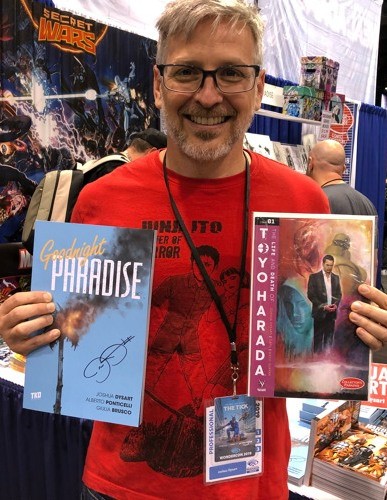 Joshua Dysart
Joshua Dysart
Born in 1971, Joshua Dysart is a professional comic book writer since 1997, when he realised, together with William O’Neil, Violent Messiah for Image Comics. From 2008 to 2011 he wrote the highly praised Vertigo series Unknown Soldier, insieme ad Alberto Ponticelli e Pat Masioni. The series got a nomination to the Eisner Awards in 2011. Since 2012 he has been one of the main author involved in the relaunch of Valiant Entertainment, writing Harbinger, Harbinger Wars, Imperium, The Life and Death of Toyo Harada. During his career e worked on Swamp Thing and Hellboy, collaborating with many artists, like Mike Mignola, Richard Corben, John Totleben, Igor Kordey, Enrique Breccia, Rick Veitch, Fábio Moon & Gabriel Bá and Eric Powell. Beside his work as a writer, he has taught in many universities and institutes, like the Ohio Aesthetics Technology Lab, The University of Miami and The Minneapolis Institute of Art.
http://www.joshuadysart.com/wp/about/



